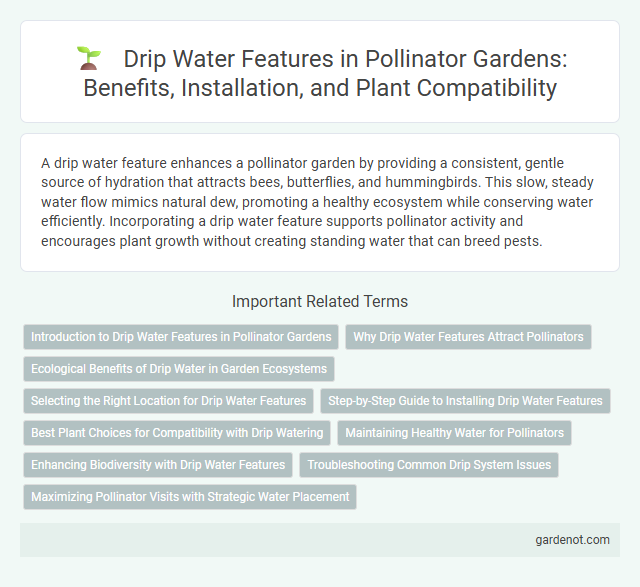A drip water feature enhances a pollinator garden by providing a consistent, gentle source of hydration that attracts bees, butterflies, and hummingbirds. This slow, steady water flow mimics natural dew, promoting a healthy ecosystem while conserving water efficiently. Incorporating a drip water feature supports pollinator activity and encourages plant growth without creating standing water that can breed pests.
Introduction to Drip Water Features in Pollinator Gardens
Drip water features in pollinator gardens provide targeted, efficient irrigation that conserves water while supporting nectar-rich plants. These systems deliver slow, precise moisture directly to the roots, promoting healthy growth of pollinator-friendly species such as milkweed, coneflowers, and bee balm. Implementing drip irrigation enhances habitat sustainability by reducing water runoff and encouraging diverse pollinator populations like bees, butterflies, and hummingbirds.
Why Drip Water Features Attract Pollinators
Drip water features provide a gentle, consistent water source that attracts pollinators such as bees, butterflies, and hummingbirds by mimicking natural hydration spots without flooding or strong currents. The slow release of water helps maintain moisture levels in the surrounding soil and plants, supporting the growth of nectar-rich flowers essential for pollinator nourishment. Additionally, the sound and movement of dripping water signal a safe habitat, increasing pollinator visitation and promoting biodiversity in the garden.
Ecological Benefits of Drip Water in Garden Ecosystems
Drip water features in pollinator gardens provide precise hydration that minimizes water waste and supports soil health, fostering a balanced ecosystem. By delivering moisture directly to plant roots, drip irrigation reduces evaporation and runoff, promoting efficient water use and sustaining native pollinators' habitats. This targeted watering method also helps maintain optimal soil moisture levels, encouraging diverse plant growth crucial for pollinator biodiversity.
Selecting the Right Location for Drip Water Features
Selecting the right location for drip water features in a pollinator garden ensures efficient water delivery to plants while minimizing evaporation and runoff. Ideal placement is near flowering plants that attract bees, butterflies, and hummingbirds, providing them with consistent hydration without flooding the area. Positioning the drip system in shaded or partially shaded spots helps maintain soil moisture levels critical for supporting diverse pollinator species.
Step-by-Step Guide to Installing Drip Water Features
Begin installing a drip water feature by positioning the main water supply line near your pollinator garden, ensuring easy access to a faucet or hose bib. Next, lay out the drip tubing along plant rows, securing it with stakes and evenly spacing drip emitters to deliver precise moisture to each plant's root zone. Finally, connect the tubing to the water source using a pressure regulator, filter, and timer for efficient water distribution and automated irrigation tailored to pollinator-friendly plants.
Best Plant Choices for Compatibility with Drip Watering
Succulents such as Sedum and Agave thrive with drip watering due to their low water requirements and excellent drainage needs. Native wildflowers like Echinacea and Butterfly Weed are also ideal, as they benefit from consistent moisture without waterlogging. Ornamental grasses including Blue Fescue and Mexican Feather Grass adapt well to drip irrigation, promoting healthy growth and supporting pollinator activity.
Maintaining Healthy Water for Pollinators
A drip water feature provides a gentle, consistent water source critical for pollinators like bees and butterflies, ensuring they stay hydrated without drowning risks. Regular cleaning and checking for algae buildup prevent water contamination, maintaining optimal water quality that supports pollinator health. Using filtered or rainwater minimizes chemical exposure, promoting a safe environment within the pollinator garden.
Enhancing Biodiversity with Drip Water Features
Drip water features create consistent moisture levels that support diverse plant species, attracting a wide range of pollinators such as bees, butterflies, and hummingbirds. By providing targeted hydration, these features reduce water waste and help establish microhabitats critical for native flora and fauna. Integrating drip irrigation systems into pollinator gardens boosts biodiversity by sustaining resilient ecosystems in varying environmental conditions.
Troubleshooting Common Drip System Issues
Drip water features in pollinator gardens often face clogging caused by mineral deposits or debris, requiring routine flushing and filter cleaning to maintain optimal water flow. Low water pressure problems can be diagnosed by checking for leaks, ensuring proper valve adjustments, and verifying the pump's performance. Regular inspection and prompt repair of damaged tubing or emitters prevent uneven watering and promote a healthy environment for pollinators.
Maximizing Pollinator Visits with Strategic Water Placement
Strategic placement of drip water features within a pollinator garden enhances accessibility for species like bees, butterflies, and hummingbirds, increasing their frequent visits. Providing shallow, slow-dripping water sources near flowering plants meets hydration needs without risking pollinator drowning. Optimal drip water placement fosters a thriving habitat by supporting pollinator health and encouraging sustained garden activity.
Drip water feature Infographic

 gardenot.com
gardenot.com